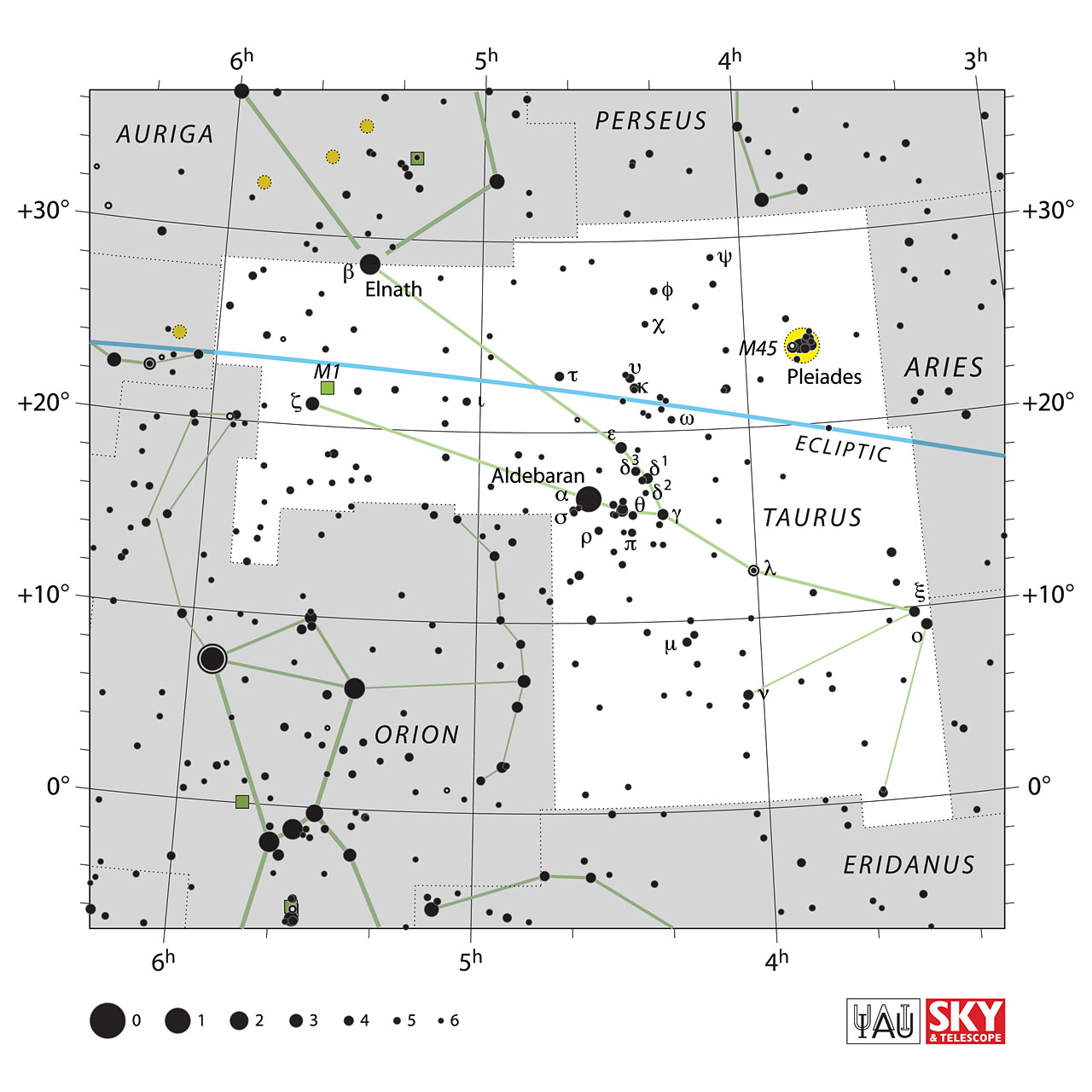Taurus


Taurus is a prominent northern constellation, lying immediately north-west of Orion. It is highest in the evening sky in the months around December.
Two objects in Taurus stand out to the unaided eye: the bright star Aldebaran, the thirteenth brightest in the whole sky, and the Pleiades star cluster (M45). The Pleiades is one of the brightest of all open clusters, visible to the naked eye as a smudge. In ancient times it was known as the ‘seven sister’, though only six stars are actually visible without optical aid.
Aldebaran itself lies within another bright star cluster, the Hyades cluster which forms a V-shape.
Taurus is depicted as a bull, within which the Hyades cluster forms the bull’s head. North-east of this, the stars β-Tau and ζ-Tau mark the tips of the bull’s horns. Close to the bull’s right horn lies another remarkable deep sky object, the Crab Nebula (M1), which is the remnant of a supernova explosion seen by Chinese observers in 1054.
The association of Taurus with a bull predates Greek mythology, and the Sumerians linked the bull with Orion, supposing the hunter to be facing the charging animal. In Greece, however, Orion was associated instead with the two hunting dogs Canis Major and Canis Minor, in pursuit of the hare Lepus. Instead, according to some accounts, Taurus perhaps depicted Zeus, who took the form of a bull in order to abduct Europa.
In the Old Babylonian Epic of Gilgamesh, the goddess Ishtar sends Taurus, the Bull of Heaven, to kill Gilgamesh for spurning her advances. Enkidu tears off the bull’s hind part and hurls the quarters into the sky where they become the stars we know as Ursa Major and Ursa Minor. Some locate Gilgamesh as the neighboring constellation of Orion, facing Taurus as if in combat
According to Greek mythology, Tarus is the bull that carried the beautiful Europa over the seas to the region of the world that now bears her name. Europa was the beautiful daughter of Agenor, King of Phoenicia. It is said that Europa was so beautiful that Zeus fell madly in love with her. So Zeus changed himself into a snow-white bull and mingled with the herds of Agenor for which Europa was caring. Europa was charmed by the beauty of this great white bull and she began to stroke its neck and pat its shoulders. Finally, she climbed onto its broad back. The bull immediately began to move out across the sea to Crete where he (Zeus) reassumed his divine form right before Europa’s startled eyes. Zeus had successfully kidnapped Europa. To commemorate his feat, he placed the picture of Tarus among the constellations, and on earth a continent was named for Europa.
Along with the constellation of Taurus, Greek mythology also tells us of a tale of the Seven Sisters a.k.a The Pleiades. Of all the constellations in the sky, no group of stars has been known longer nor had more different stories, legends, or myths told about it than the Pleiades. There are at least 43 different stories or names for them. However, there are only two that are closely related to the Greek heroes or gods. The Pleiades, according to the first Greek myth, were the seven daughters of Pleione and Atlas, the giant who bears the world upon his shoulders. These seven maidens, along with their sisters the Hyades, (these are the small stars forming the face of Tarus) were transformed into stars because of their “amiable virtues and mutual affection” and because of their great sorrow at the burden imposed upon their father, Atlas. The second myth concerning the Pleiades tells how they were so beautiful that Orion was constantly chasing them, which caused them a great amount of discomfort. They appealed to Zeus for help and in pity for them he changed them into doves. As doves they then flew up into the sky and found a hiding place among the stars.
Taurus is one of the twelve zodiacal constellations, and the Sun passes through it each year between mid-May and mid-June. Because of the Zodiac constellation status of Taurus, it is given the symbol ![]() and emoji ♉.
and emoji ♉.
In the Indian system of Astronomy, Taurus is called ವೃಷಭ (Vrushabha).
Taurus contains:
-
Stars
- Aldebaran (mag 1.0)
- Elnath (mag 1.7)
- Alcyone (mag 2.9)
- ζ-Tau (mag 3.0)
- θ²-Tau (mag 3.4)
- λ-Tau (mag 3.4)
- Ain (mag 3.5)
- Atlas (mag 3.6)
- O-Tau (mag 3.6)
- γ-Tau (mag 3.6)
- Electra (mag 3.7)
- ξ-Tau (mag 3.7)
- δ-Tau (mag 3.8)
- θ¹-Tau (mag 3.8)
- Maia (mag 3.9)
- ν-Tau (mag 3.9)
- f-Tau (mag 4.1)
- Merope (mag 4.2)
- κ-Tau (mag 4.2)
- τ-Tau (mag 4.3)
- d-Tau (mag 4.3)
- V776 Tau (mag 4.3)
- c¹-Tau (mag 4.3)
- μ-Tau (mag 4.3)
- υ-Tau (mag 4.3)
-
Open Clusters
-
Globular Clusters
- None
-
Galaxy
- NGC 1642 (mag 12.9)
- NGC 1587 (mag 13.3)
- NGC 1474 (mag 13.8)
- NGC 1589 (mag 13.8)
- NGC 1542 (mag 13.9)
- NGC 1550 (mag 14.0)
- NGC 1588 (mag 14.1)
- NGC 1517 (mag 14.3)
- IC 357 (mag 14.3)
- NGC 1497 (mag 14.5)
- IC 1967 (mag 14.5)
- IC 331 (mag 14.5)
- IC 329 (mag 14.5)
- NGC 1633 (mag 14.6)
- NGC 1590 (mag 14.6)
- IC 1977 (mag 14.6)
- NGC 1409 (mag 14.7)
- NGC 1593 (mag 14.8)
- IC 365 (mag 14.8)
- NGC 1541 (mag 14.9)
- NGC 1615 (mag 15.0)
- NGC 1349 (mag 15.0)
- IC 338 (mag 15.0)
- IC 332 (mag 15.0)
- IC 330 (mag 15.0)
View Taurus in 3D 
Source: Wikipedia, in-the-sky.org
Image Courtesy: Sky&Telescope & IAU, Illustration Images linked from Urania's Mirror on Wikmedia Commons by Sidney Hall
Image Courtesy: Sky&Telescope & IAU, Illustration Images linked from Urania's Mirror on Wikmedia Commons by Sidney Hall
